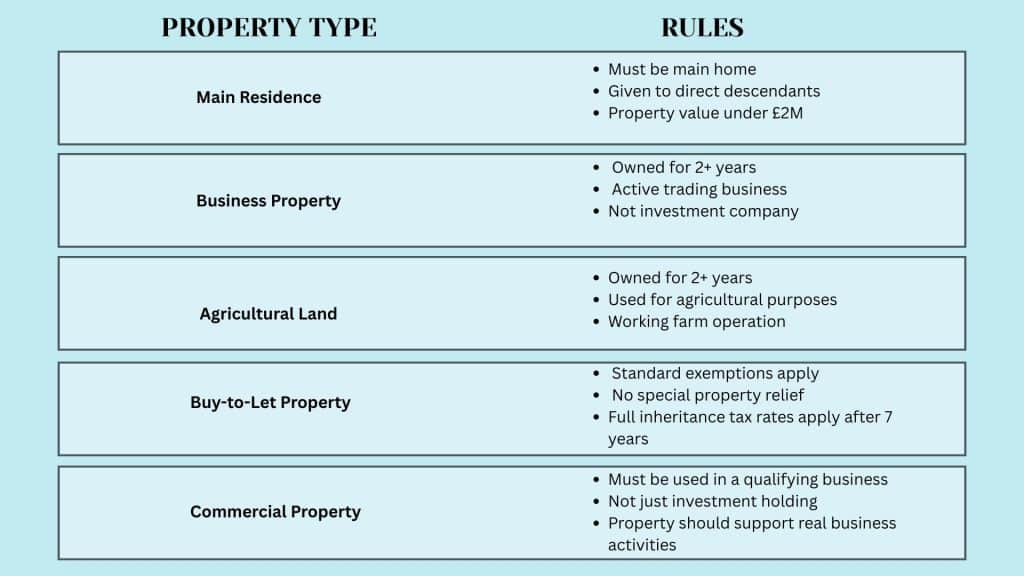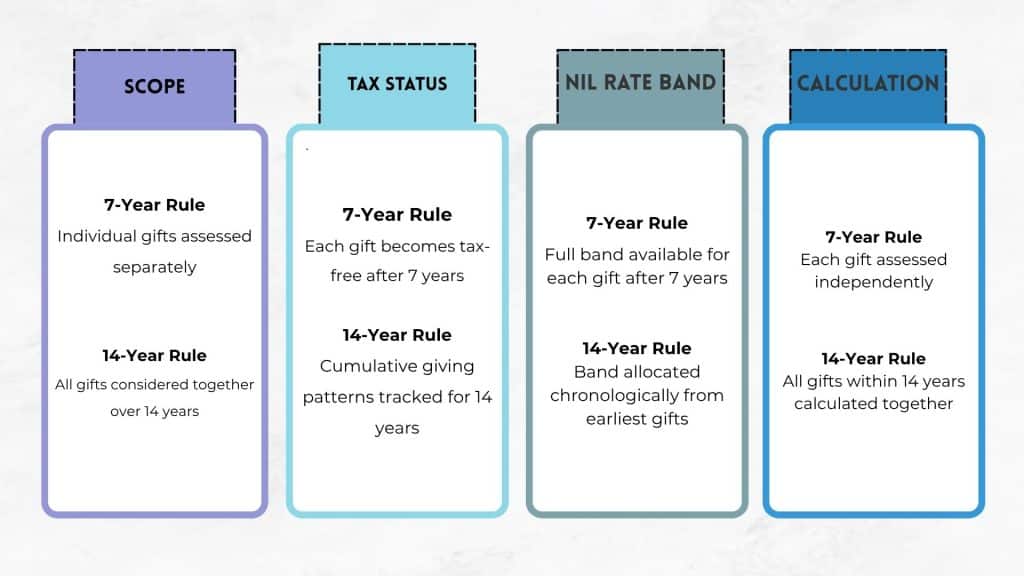Have you ever wondered why property experts keep talking about surviving seven years after giving away your home or land?
Most property owners don’t realize that this seemingly random timeframe can mean the difference between a tax-free gift and a hefty inheritance tax bill that could cost your family thousands.
I’ve spent years helping people understand property tax rules, and I can tell you that the 7-year rule is one of the most misunderstood concepts in property planning.
Once you grasp how it works, you’ll be able to make smarter decisions about transferring property, whether it’s to your children, into a trust, or as part of your estate planning strategy.
Let me walk you through precisely what the 7-year rule means for property owners, how it affects different types of property transfers, and, most importantly, how you can use this knowledge to protect your family’s wealth.
What is the 7-Year Rule on Property?
The rule on property refers to several important legal concepts that affect property ownership and taxation. This rule applies in various areas of property law and can impact your financial planning.
From inheritance tax relief to capital gains benefits, the 7-year timeframe determines when property transfers become tax-free. Understanding these applications helps you time your property decisions for maximum tax savings.
Key Areas Where the Rule Applies
-
Inheritance Tax Planning – When you give away property or assets, you must survive for this specific period after the gift for it to be completely free from inheritance tax. If you pass away within this timeframe, the gift may still be subject to tax on a sliding scale.
Capital Gains Tax Relief – Some property transactions qualify for tax relief if you meet certain conditions over this extended period. This often applies to business property or investment assets.
Adverse Possession Claims – In some jurisdictions, continuous occupation of land for a specified duration can strengthen legal claims to property ownership, although this varies by location.
Property Investment Rules – Certain tax benefits for property investors require holding periods of this length or more to qualify for favorable treatment.
Understanding these rules enables you to make informed decisions about property transfers, tax planning, and investment strategies. Each situation has specific requirements, so professional advice is often needed.
How the 7-Year Rule Applies to Property?
Property gifts are subject to specific rules under the 7-year inheritance tax system. Here’s a comprehensive overview of how the rule affects property transfers:
| Years Survived After Gift | Tax Rate | Property Value: £400,000 | Property Value: £600,000 | Key Rules |
|---|---|---|---|---|
| 0-3 years | 40% | £160,000 tax | £240,000 tax | Full inheritance tax rate applies |
| 3-4 years | 32% | £128,000 tax | £192,000 tax | Taper relief: 20% reduction |
| 4-5 years | 24% | £96,000 tax | £144,000 tax | Taper relief: 40% reduction |
| 5-6 years | 16% | £64,000 tax | £96,000 tax | Taper relief: 60% reduction |
| 6-7 years | 8% | £32,000 tax | £48,000 tax | Taper relief: 80% reduction |
| 7+ years | 0% | No tax | No tax | Complete exemption – gift becomes tax-free |
When calculating inheritance tax on property gifts, several factors determine the final liability. The tax is based on the property’s value at the time of the gift, not its current worth. Even if the property increases in value afterward, the tax remains fixed at the original amount.
Taper relief reduces the tax burden, but only applies if the donor survives for three years after the gift is made. For main residence transfers, additional relief may be available through the residence nil-rate band.
With jointly owned properties, only the gifted share counts toward tax, allowing for partial transfers that can reduce liability.
Exemptions & Allowances of the 7-Year Property Rule

The rule on the property is accompanied by several important exemptions and allowances that can help you reduce or eliminate your tax liability. Understanding these provisions is crucial for effective property planning and can result in significant tax savings.
1. Annual Exemptions Provide Immediate Relief
Every individual can gift up to £3,000 per year without any tax consequences or waiting periods. This annual exemption resets each tax year, allowing you to make regular gifts within this limit without triggering the seven-year gift tax exclusion period.
Additionally, you can make small gifts of up to £250 per person to as many people as you want, as long as you haven’t used your principal annual exemption for that person.
2. Wedding and Civil Partnership Gifts
Receive special treatment under the exemption rules. Parents can give up to £5,000 for their child’s wedding, grandparents can provide £2,500, and other relatives or friends can give up to £1,000.
These gifts are immediately tax-free and don’t count toward your annual exemption limits.
3. Spousal Transfers
Offer the most generous exemption available. If you’re married or in a civil partnership and both partners are UK residents, you can transfer unlimited amounts between yourselves without any tax implications.
However, if one spouse is not a UK resident, the exemption is limited to £325,000, and amounts above this threshold are subject to this rule.
4. Property-Specific Exemptions
Can provide complete relief for certain types of assets. Business property relief offers up to 100% exemption for qualifying business assets, including commercial property used in your business.
Agricultural property relief provides similar benefits for farmland and farm buildings. Your main residence may also qualify for special treatment under residence nil rate band rules.
5. Nil Rate Band Allowances
Set the threshold for when inheritance tax becomes payable. The current standard nil rate band is £325,000 per person, meaning gifts within this lifetime limit don’t attract immediate tax.
The residence nil rate band provides an additional £175,000 specifically for your main home when passed to direct descendants. These allowances can be combined and transferred between spouses, potentially creating a total allowance of £1 million for a couple.
6. Taper Relief
Provides graduated tax reduction for gifts made between 3-7 years before death. While this doesn’t eliminate the 7-year rule requirement, it significantly reduces the tax burden on a sliding scale.
The relief starts at 20% for gifts made 3-4 years before death and increases to 80% for gifts made 6-7 years prior to death.
7. Charity Donations
They are completely exempt from tax obligations with no upper limit. You can give unlimited amounts to registered charities without any tax consequences or waiting periods.
This exemption makes charitable giving an attractive option for estate planning purposes. Understanding these exemptions and allowances helps you structure your property gifts more effectively and potentially avoid the seven-year survival period entirely for many transfers.”
Property-Specific Considerations for the 7-Year Rule
Main residences get special treatment with enhanced allowances, while business and agricultural properties may qualify for immediate relief.
Buy-to-let properties face the strictest rules, with standard inheritance tax rates applying throughout the whole 7-year period.

The type of property you own determines your tax treatment under this rule, with family homes receiving the most favorable terms and rental properties facing the highest tax burden.
The 14-Year Rule: An Extension to Be Aware Of
The 14-year rule is a lesser-known extension of the 7-year rule that can significantly impact your property planning strategy. While most people focus on the standard 7-year survival period, specific situations exist where tax implications extend to 14 years after making a gift.
This rule becomes relevant when you make multiple large gifts or exceed your nil rate band within certain timeframes. Understanding this extension helps you avoid unexpected tax bills that can arise even when individual gifts appear to qualify for 7-year relief. Proper planning requires considering both rules together.
Key Considerations When Planning for the 14-Year Rule
Comprehending the 14-year rule becomes essential if you’re considering multiple large gifts, particularly to ensure that your estate and inheritance tax planning aligns with both the 7-year and 14-year timeframes.
-
Multiple Large Gifts: If you give various assets to different people over several years, the cumulative value may exceed your nil-rate band. This could trigger additional inheritance tax, even if each gift is under the threshold for the 7-year rule. This requires careful planning to balance your gifting strategy over time.
-
Exceeding the Nil Rate Band: If the total value of your lifetime gifts exceeds the £325,000 nil rate band, the 14-year rule may come into effect. The combined value of gifts within this extended period could trigger tax liabilities that aren’t immediately obvious.
-
Strategic Gift Giving: To mitigate potential tax consequences, it’s essential to plan your gifts strategically. Spreading them out or taking advantage of exemptions like the annual gift allowance or spousal exemptions can help reduce the overall tax burden, keeping your family’s wealth intact while still benefiting from the 7-year rule.
Key Differences: 7 Years vs 14 Years Rule
The seven-year survival period examines individual gift transfers separately, whereas the 14-year rule considers your overall giving pattern over time.
This difference means single property transfers suit the seven-year approach, while the 14-year rule involves complex planning for multiple large gifts to different recipients.”

This year’s rule works best for single gifts, allowing you to wait out the survival period, while the 14-year rule requires careful planning of multiple transfers to reduce cumulative tax and prevent earlier gifts from causing surprises later.
Conclusion
Now that you understand the 7-year rule on property, you can see why it’s such a powerful tool for family wealth protection.
Whether you’re planning to gift property to your children, considering business property transfers, or want to reduce your inheritance tax liability, this rule gives you a clear roadmap.
The key takeaway? Time is your greatest asset when it comes to property planning.
The sooner you start planning your property transfers, the more opportunities you have to use exemptions and allowances to your advantage.
Don’t let complex tax rules catch your family off guard. Start reviewing your property portfolio today and consider how the 7-year rule could work for your situation. Remember, professional advice is always worth the investment when it comes to valuable property assets.
What’s your biggest concern about property transfers?














